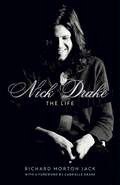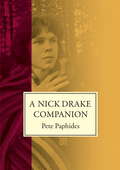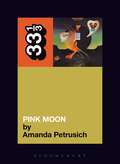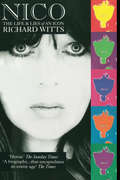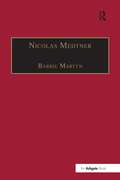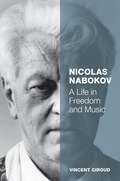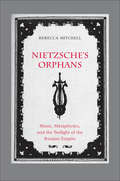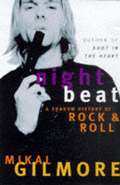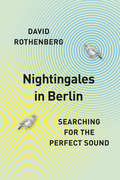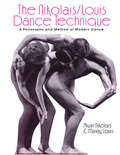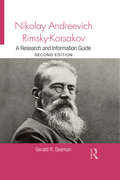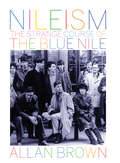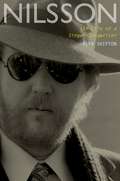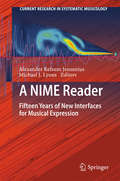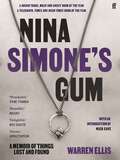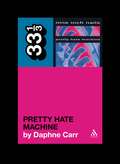- Table View
- List View
Nick Drake: The Life
by Richard Morton Jack'This is the book we've been waiting for - the one Nick's legacy deserves and so badly needs. Richard Morton Jack has reconstructed Nick's life with great sensitivity and care, and in remarkable detail. It is a biography to be treasured' Joe BoydIn 1968 Nick Drake had everything to live for. The product of a loving, creative family and a privileged background, he was not only a handsome and popular Cambridge undergraduate, but also a new signing to the UK's hippest record label, Island.Three years later, however - having made three well-reviewed but low-selling albums - Nick had been overwhelmed by a mysterious mental illness. He returned to live in his family home in rural Warwickshire in 1971, and died in obscurity in 1974, aged just 26.In the decades since, Nick has become the subject of ever-growing fascination and speculation. Combined sales of his records now stand in the millions, his songs are frequently heard on TV and in films, and he has become one of the most widely known and admired singer-songwriters of his generation.Nick Drake: The Life is the only biography of Nick to be written with the blessing and involvement of his sister and Estate. Drawing on copious original research and new interviews with his family, friends and musical collaborators, as well as deeply personal archive material unavailable to previous writers - including his father's diaries, his essays and private correspondence - this is the most comprehensive and authoritative account possible of Nick's short and enigmatic life.Includes a foreword by Gabrielle Drake and over 75 photos, many rare or previously unseen.
A Nick Drake Companion
by Pete PaphidesThis short book, taken from Remembered For A While, tells the stories and circumstances that surround every known recording in Nick Drake's canon (as well as a few unrecorded songs). The result is like a detailed, extended series of liner notes, something to read while sitting in your favourite chair, in your favourite room, listening to the imperishably beautiful music they describe. A Nick Drake companion.
Nick Drake's Pink Moon (33 1/3)
by Amanda PetrusichPink Moon explores how Nick Drake's third and final album has puttered and purred its way into a new millennium. Features interviews with producer Joe Boyd, string arranger Robert Kirby, and even the marketing team behind the VW Cabrio commercial that launched the album to platinum status more than thirty years after its release.
Nick Drake's Pink Moon (33 1/3)
by Amanda PetrusichPink Moon explores how Nick Drake's third and final album has puttered and purred its way into a new millennium. Features interviews with producer Joe Boyd, string arranger Robert Kirby, and even the marketing team behind the VW Cabrio commercial that launched the album to platinum status more than thirty years after its release.
Nico: The Life And Lies Of An Icon
by Richard WittsNico was revered as ‘the most beautiful creature who ever lived’. She was Andy Warhol’s femme fatale and the High Preistess of Weird, yet few knew her real name or her wretched origins. When she called herself ‘a Nazi anarchist junkie’, they thought she was joking.Bob Dylan wrote a song about her, Jim Morrison a poem, Jean Baudrillard an essay, Andy Warhol a film, Ernest Hemingway a story – yet she fought against the idolatry of men to assert her independence as a composer of dissident songs.Nico’s contribution as an artist (17 films and 7 LPs) was smothered by gossip of her alleged affairs with men and women, whether Jimi Hendrix or Jeanne Moreau, Brian Jones of the Rolling Stones or Coco Chanel.She drifted through society like a phantom. Each era celebrated a different Nico – the top covergirl of the Fifties, the Siren of the Sixties (as The Times acclaimed her), the Moon Goddess of the Seventies, and the High Priestess of Punk when rock stars like Siouxsie Sioux and Pattie Smith acknowledged her pre-eminence. Ironically, they did so at the lowest point in her life. For behind the Garbo-esque veneer lived a lonely woman trying to stand autonomous in a fast-changing world, seeking to survive her heroin addiction and to cope with her tormented mother and her troubled son, his existence denied by his film-star father.In this pioneer biography, which Nico asked the author to write shortly before her outlandish death in 1988, Richard Witts uncovers the reasons for her subterfuge, and examines the facts surrounding her encounters with terrorist Andreas Baader, the Black Panthers, and the Society for Cutting Up Men. Exclusive contributions from artists such as Jackson Browne, Iggy Pop, Viva, John Cale, David Bailey, Siouxsie Sioux – and many others including her relatives, friends and enemies – make this the definitive biography of an icon who was not only a testament to an era but hitherto unrecognised influence on popular music and style.
Nicolas Medtner: His Life and Music
by Barrie MartynNicholas Medtner (1880-1951) has always been a neglected figure in the history of Russian music, and yet his friend Rachmaninoff considered him the greatest of contemporary composers. He wrote three fine piano concertos, more than one hundred solo piano compositions, including a cycle of fourteen sonatas fully worthy to be set alongside those of Scriabin and Prokofiev, and many beautiful songs. He was also a great pianist. Leaving Russia after the Bolshevik Revolution, Medtner lived for a time in Germany and France before finally settling in London, where he passed the final sixteen years of his life. The present work is the first to tell the full story of his eventful life and to consider in turn each of his compositions. The author has drawn on Medtner‘s own correspondence and writings and collected the reminiscences of those who knew him personally to build a comprehensive picture of a great, if still largely unrecognised, musician.
Nicolas Medtner: His Life and Music
by Barrie MartynNicholas Medtner (1880-1951) has always been a neglected figure in the history of Russian music, and yet his friend Rachmaninoff considered him the greatest of contemporary composers. He wrote three fine piano concertos, more than one hundred solo piano compositions, including a cycle of fourteen sonatas fully worthy to be set alongside those of Scriabin and Prokofiev, and many beautiful songs. He was also a great pianist. Leaving Russia after the Bolshevik Revolution, Medtner lived for a time in Germany and France before finally settling in London, where he passed the final sixteen years of his life. The present work is the first to tell the full story of his eventful life and to consider in turn each of his compositions. The author has drawn on Medtner‘s own correspondence and writings and collected the reminiscences of those who knew him personally to build a comprehensive picture of a great, if still largely unrecognised, musician.
Nicolas Nabokov: A Life in Freedom and Music
by Vincent GiroudComposer, cultural diplomat, and man about town, Nicolas Nabokov (1903-78) counted among his intimate friends everyone from Igor Stravinsky to George Kennan. While today he is overshadowed by his more famous cousin Vladimir, Nicolas Nabokov was during his lifetime an outstanding and far-sighted player in international cultural exchanges during the Cold War and admired by some of the most distinguished minds of his century for his political acumen and his talents as a composer. This first-ever biography of Nabokov follows the fascinating stages of his life: a privileged childhood before the Revolution; the beginnings of a promising musical career launched under the aegis of Diaghilev; his involvement in anti-Stalinist causes in the first years of the Cold War; his participation in the Congress for Cultural Freedom; his role as cultural advisor to the Mayor of Berlin and director of the Berlin Festival in the early 1960s; his American academic and musical career in the late 1960s and 1970s. Nabokov is unique not only in that he was involved on a high level in international cultural politics, but also in that his life intersected at all times with a vast array of people within - and also well beyond - the confines of classical music. Drawing on a vast array of primary sources, Vincent Giroud's biography opens a window into history for readers interested in twentieth-century music, Russian emigration, and the Cold War, particularly in its cultural aspects. Musicians and musicologists interested in Nabokov as a composer, or in twentieth century Russian composers in general, will find in this book information not available anywhere else.
Nicolas Nabokov: A Life in Freedom and Music
by Vincent GiroudComposer, cultural diplomat, and man about town, Nicolas Nabokov (1903-78) counted among his intimate friends everyone from Igor Stravinsky to George Kennan. While today he is overshadowed by his more famous cousin Vladimir, Nicolas Nabokov was during his lifetime an outstanding and far-sighted player in international cultural exchanges during the Cold War and admired by some of the most distinguished minds of his century for his political acumen and his talents as a composer. This first-ever biography of Nabokov follows the fascinating stages of his life: a privileged childhood before the Revolution; the beginnings of a promising musical career launched under the aegis of Diaghilev; his involvement in anti-Stalinist causes in the first years of the Cold War; his participation in the Congress for Cultural Freedom; his role as cultural advisor to the Mayor of Berlin and director of the Berlin Festival in the early 1960s; his American academic and musical career in the late 1960s and 1970s. Nabokov is unique not only in that he was involved on a high level in international cultural politics, but also in that his life intersected at all times with a vast array of people within - and also well beyond - the confines of classical music. Drawing on a vast array of primary sources, Vincent Giroud's biography opens a window into history for readers interested in twentieth-century music, Russian emigration, and the Cold War, particularly in its cultural aspects. Musicians and musicologists interested in Nabokov as a composer, or in twentieth century Russian composers in general, will find in this book information not available anywhere else.
Nietzsche's Orphans: Music, Metaphysics, and the Twilight of the Russian Empire (Eurasia Past and Present)
by Rebecca MitchellA prevailing belief among Russia’s cultural elite in the early twentieth century was that the music of composers such as Sergei Rachmaninoff, Aleksandr Scriabin, and Nikolai Medtner could forge a shared identity for the Russian people across social and economic divides. In this illuminating study of competing artistic and ideological visions at the close of Russia’s “Silver Age,” author Rebecca Mitchell interweaves cultural history, music, and philosophy to explore how “Nietzsche’s orphans” strove to find in music a means to overcome the disunity of modern life in the final tumultuous years before World War I and the Communist Revolution.
Night Beat: A Shadow History of Rock & Roll
by Mikal GilmoreNight Beat is a look at the disruption of culture as viewed through the history of rock music, its activists, its politics, the lives lived and lives grieved for during an epoch of upheaval. The author’s personal touchstones (Bob Dlan, John Lydon, Lou Reed and others) are mixed with his interviews and encounters as a Rolling Stone journalist (such as The Clash, Sinéad O’Connor, Miles Davis and Keith Jarrett) and a sampling of critical indulgences. This book is a mix of the best of Mikal Gilmore’s writing and new and re-fashioned pieces which together tell the story of the people who made rock music, and who will carry rock & roll into the twenty-first century.
Nightingales in Berlin: Searching for the Perfect Sound
by David RothenbergA celebrated figure in myth, song, and story, the nightingale has captivated the imagination for millennia, its complex song evoking a prism of human emotions,—from melancholy to joy, from the fear of death to the immortality of art. But have you ever listened closely to a nightingale’s song? It’s a strange and unsettling sort of composition—an eclectic assortment of chirps, whirs, trills, clicks, whistles, twitters, and gurgles. At times it is mellifluous, at others downright guttural. It is a rhythmic assault, always eluding capture. What happens if you decide to join in? As philosopher and musician David Rothenberg shows in this searching and personal new book, the nightingale’s song is so peculiar in part because it reflects our own cacophony back at us. As vocal learners, nightingales acquire their music through the world around them, singing amidst the sounds of humanity in all its contradictions of noise and beauty, hard machinery and soft melody. Rather than try to capture a sound not made for us to understand, Rothenberg seeks these musical creatures out, clarinet in tow, and makes a new sound with them. He takes us to the urban landscape of Berlin—longtime home to nightingale colonies where the birds sing ever louder in order to be heard—and invites us to listen in on their remarkable collaboration as birds and instruments riff off of each other’s sounds. Through dialogue, travel records, sonograms, tours of Berlin’s city parks, and musings on the place animal music occupies in our collective imagination, Rothenberg takes us on a quest for a new sonic alchemy, a music impossible for any one species to make alone. In the tradition of The Hidden Life of Trees and The Invention of Nature, Rothenberg has written a provocative and accessible book to attune us ever closer to the natural environment around us.
Nightingales in Berlin: Searching for the Perfect Sound
by David RothenbergA celebrated figure in myth, song, and story, the nightingale has captivated the imagination for millennia, its complex song evoking a prism of human emotions,—from melancholy to joy, from the fear of death to the immortality of art. But have you ever listened closely to a nightingale’s song? It’s a strange and unsettling sort of composition—an eclectic assortment of chirps, whirs, trills, clicks, whistles, twitters, and gurgles. At times it is mellifluous, at others downright guttural. It is a rhythmic assault, always eluding capture. What happens if you decide to join in? As philosopher and musician David Rothenberg shows in this searching and personal new book, the nightingale’s song is so peculiar in part because it reflects our own cacophony back at us. As vocal learners, nightingales acquire their music through the world around them, singing amidst the sounds of humanity in all its contradictions of noise and beauty, hard machinery and soft melody. Rather than try to capture a sound not made for us to understand, Rothenberg seeks these musical creatures out, clarinet in tow, and makes a new sound with them. He takes us to the urban landscape of Berlin—longtime home to nightingale colonies where the birds sing ever louder in order to be heard—and invites us to listen in on their remarkable collaboration as birds and instruments riff off of each other’s sounds. Through dialogue, travel records, sonograms, tours of Berlin’s city parks, and musings on the place animal music occupies in our collective imagination, Rothenberg takes us on a quest for a new sonic alchemy, a music impossible for any one species to make alone. In the tradition of The Hidden Life of Trees and The Invention of Nature, Rothenberg has written a provocative and accessible book to attune us ever closer to the natural environment around us.
Nightingales in Berlin: Searching for the Perfect Sound
by David RothenbergA celebrated figure in myth, song, and story, the nightingale has captivated the imagination for millennia, its complex song evoking a prism of human emotions,—from melancholy to joy, from the fear of death to the immortality of art. But have you ever listened closely to a nightingale’s song? It’s a strange and unsettling sort of composition—an eclectic assortment of chirps, whirs, trills, clicks, whistles, twitters, and gurgles. At times it is mellifluous, at others downright guttural. It is a rhythmic assault, always eluding capture. What happens if you decide to join in? As philosopher and musician David Rothenberg shows in this searching and personal new book, the nightingale’s song is so peculiar in part because it reflects our own cacophony back at us. As vocal learners, nightingales acquire their music through the world around them, singing amidst the sounds of humanity in all its contradictions of noise and beauty, hard machinery and soft melody. Rather than try to capture a sound not made for us to understand, Rothenberg seeks these musical creatures out, clarinet in tow, and makes a new sound with them. He takes us to the urban landscape of Berlin—longtime home to nightingale colonies where the birds sing ever louder in order to be heard—and invites us to listen in on their remarkable collaboration as birds and instruments riff off of each other’s sounds. Through dialogue, travel records, sonograms, tours of Berlin’s city parks, and musings on the place animal music occupies in our collective imagination, Rothenberg takes us on a quest for a new sonic alchemy, a music impossible for any one species to make alone. In the tradition of The Hidden Life of Trees and The Invention of Nature, Rothenberg has written a provocative and accessible book to attune us ever closer to the natural environment around us.
Nightingales in Berlin: Searching for the Perfect Sound
by David RothenbergA celebrated figure in myth, song, and story, the nightingale has captivated the imagination for millennia, its complex song evoking a prism of human emotions,—from melancholy to joy, from the fear of death to the immortality of art. But have you ever listened closely to a nightingale’s song? It’s a strange and unsettling sort of composition—an eclectic assortment of chirps, whirs, trills, clicks, whistles, twitters, and gurgles. At times it is mellifluous, at others downright guttural. It is a rhythmic assault, always eluding capture. What happens if you decide to join in? As philosopher and musician David Rothenberg shows in this searching and personal new book, the nightingale’s song is so peculiar in part because it reflects our own cacophony back at us. As vocal learners, nightingales acquire their music through the world around them, singing amidst the sounds of humanity in all its contradictions of noise and beauty, hard machinery and soft melody. Rather than try to capture a sound not made for us to understand, Rothenberg seeks these musical creatures out, clarinet in tow, and makes a new sound with them. He takes us to the urban landscape of Berlin—longtime home to nightingale colonies where the birds sing ever louder in order to be heard—and invites us to listen in on their remarkable collaboration as birds and instruments riff off of each other’s sounds. Through dialogue, travel records, sonograms, tours of Berlin’s city parks, and musings on the place animal music occupies in our collective imagination, Rothenberg takes us on a quest for a new sonic alchemy, a music impossible for any one species to make alone. In the tradition of The Hidden Life of Trees and The Invention of Nature, Rothenberg has written a provocative and accessible book to attune us ever closer to the natural environment around us.
The Nikolais/Louis Dance Technique: A Philosophy and Method of Modern Dance
by Murray Louis Alwin NikolaisFirst Published in 2005. Routledge is an imprint of Taylor & Francis, an informa company.
The Nikolais/Louis Dance Technique: A Philosophy and Method of Modern Dance
by Murray Louis Alwin NikolaisFirst Published in 2005. Routledge is an imprint of Taylor & Francis, an informa company.
Nikolay Andreevich Rimsky-Korsakov: A Research and Information Guide (Routledge Music Bibliographies)
by Gerald SeamanNikolay Andreevich Rimsky-Korsakov: A Research and Information Guide, Second Edition is an annotated bibliography of all substantial, relevant published resources relating to the Russian composer. First published in 1988, this revised and expanded volume incorporates new information about the composer appearing over the last two decades, including literary publications, articles and reviews. Other sections provide a brief biographical sketch, selective discography, chronology and list of Rimsky-Korsakov’s works.
Nikolay Andreevich Rimsky-Korsakov: A Research and Information Guide (Routledge Music Bibliographies)
by Gerald SeamanNikolay Andreevich Rimsky-Korsakov: A Research and Information Guide, Second Edition is an annotated bibliography of all substantial, relevant published resources relating to the Russian composer. First published in 1988, this revised and expanded volume incorporates new information about the composer appearing over the last two decades, including literary publications, articles and reviews. Other sections provide a brief biographical sketch, selective discography, chronology and list of Rimsky-Korsakov’s works.
Nileism: The Strange Course of the Blue Nile
by Allan BrownA book about the most emotionally articulate group to emerge from Glasgow by one of the city's most mischievously eloquent writers is cause for celebration' - The Herald 'A comprehensive and compelling read' - The List 'An insightful and enthralling peek into the world of one of the greatest acts of the modern era' - Evening Herald Ireland 2011 sees the 30th anniversary of The Blue Nile's first work together. Four albums - containing a total of just 33 songs - have followed since. Yet scarcity has served only to intensify love for the band's intensely romantic songs. Reclusive and enigmatic, The Blue Nile are one of modern music's greatest mysteries, as secretive about their plans and status as they are about their painstaking methods. For the first time Allan Brown, a fan from the time of the band's first album in 1983 and friend of the band's composer Paul Buchanan, gets behind the veil to analyse the band's agonisingly slow progress through personal memoir, critical study, access to unreleased recordings and encounters with those who have been central to the strange and elusive mythology of The Blue Nile.
Nilsson: The Life of a Singer-Songwriter
by Alyn ShiptonPaul McCartney and John Lennon described him as the Beatles' "favorite group," he won Grammy awards, wrote and recorded hit songs, and yet no figure in popular music is as much of a paradox, or as underrated, as Harry Nilsson. In this first ever full-length biography, Alyn Shipton traces Nilsson's life from his Brooklyn childhood to his Los Angeles adolescence and his gradual emergence as a uniquely talented singer-songwriter. With interviews from friends, family, and associates, and material drawn from an unfinished autobiography, Shipton probes beneath the enigma to discover the real Harry Nilsson. A major celebrity at a time when huge concerts and festivals were becoming the norm, Nilsson shunned live performance. His venue was the studio, his stage the dubbing booth, his greatest triumphs masterful examples of studio craft. He was a gifted composer of songs for a wide variety of performers, including the Ronettes, the Yardbirds, and the Monkees, yet Nilsson's own biggest hits were almost all written by other songwriters. He won two Grammy awards, in 1969 for "Everybody's Talkin'" (the theme song for Midnight Cowboy), and in 1972 for "Without You," had two top ten singles, numerous album successes, and wrote a number of songs--"Coconut" and "Jump into the Fire," to name just two--that still sound remarkably fresh and original today. He was once described by his producer Richard Perry as "the finest white male singer on the planet," but near the end of his life, Nilsson's career was marked by voice-damaging substance abuse and the infamous deaths of both Keith Moon and Mama Cass in his London flat. Drawing on exclusive access to Nilsson's papers, Alyn Shipton's biography offers readers an intimate portrait of a man who has seemed both famous and unknowable--until now.
Nilsson: The Life of a Singer-Songwriter
by Alyn ShiptonPaul McCartney and John Lennon described him as the Beatles' "favorite group," he won Grammy awards, wrote and recorded hit songs, and yet no figure in popular music is as much of a paradox, or as underrated, as Harry Nilsson. In this first ever full-length biography, Alyn Shipton traces Nilsson's life from his Brooklyn childhood to his Los Angeles adolescence and his gradual emergence as a uniquely talented singer-songwriter. With interviews from friends, family, and associates, and material drawn from an unfinished autobiography, Shipton probes beneath the enigma to discover the real Harry Nilsson. A major celebrity at a time when huge concerts and festivals were becoming the norm, Nilsson shunned live performance. His venue was the studio, his stage the dubbing booth, his greatest triumphs masterful examples of studio craft. He was a gifted composer of songs for a wide variety of performers, including the Ronettes, the Yardbirds, and the Monkees, yet Nilsson's own biggest hits were almost all written by other songwriters. He won two Grammy awards, in 1969 for "Everybody's Talkin'" (the theme song for Midnight Cowboy), and in 1972 for "Without You," had two top ten singles, numerous album successes, and wrote a number of songs--"Coconut" and "Jump into the Fire," to name just two--that still sound remarkably fresh and original today. He was once described by his producer Richard Perry as "the finest white male singer on the planet," but near the end of his life, Nilsson's career was marked by voice-damaging substance abuse and the infamous deaths of both Keith Moon and Mama Cass in his London flat. Drawing on exclusive access to Nilsson's papers, Alyn Shipton's biography offers readers an intimate portrait of a man who has seemed both famous and unknowable--until now.
A NIME Reader: Fifteen Years of New Interfaces for Musical Expression (Current Research in Systematic Musicology #3)
by Alexander Refsum Jensenius Michael J. LyonsWhat is a musical instrument? What are the musical instruments of the future? This anthology presents thirty papers selected from the fifteen year long history of the International Conference on New Interfaces for Musical Expression (NIME). NIME is a leading music technology conference, and an important venue for researchers and artists to present and discuss their explorations of musical instruments and technologies. Each of the papers is followed by commentaries written by the original authors and by leading experts. The volume covers important developments in the field, including the earliest reports of instruments like the reacTable, Overtone Violin, Pebblebox, and Plank. There are also numerous papers presenting new development platforms and technologies, as well as critical reflections, theoretical analyses and artistic experiences. The anthology is intended for newcomers who want to get an overview of recent advances in music technology. The historical traces, meta-discussions and reflections will also be of interest for longtime NIME participants. The book thus serves both as a survey of influential past work and as a starting point for new and exciting future developments.
Nina Simone's Gum: A Memoir of Things Lost and Found
by Warren EllisFrom award-winning musician and composer Warren Ellis comes the unexpected and inspiring story of a piece of chewing gum. Featuring an introduction from Nick Cave.'Warren has turned this memento, snatched from his idol's piano in a moment of rapture, into a genuine religious artefact.'NICK CAVE'In praise of meaning-rich relics and magical things. Totally heartwarming project.'MAX PORTER'A unique study of a fan's devotion, of transcendence and of the artistic vocation - it's got depth and great warmth. It's a beautiful piece of work.'KEVIN BARRYOn Thursday 1 July, 1999, Dr Nina Simone gave a rare performance as part of Nick Cave's Meltdown Festival. After the show, in a state of awe, Warren Ellis crept onto the stage, took Dr Simone's piece of chewed gum from the piano, wrapped it in her stage towel and put it in a Tower Records bag. The gum remained with him for twenty years; a sacred totem, his creative muse, growing in significance with every passing year.In 2019, Cave - his collaborator and great friend - asked Warren if there was anything he could contribute to display in his Stranger Than Kindness exhibition. Warren realised the time had come to release the gum. Together they agreed it should be housed in a glass case like a holy relic. Worrying the gum would be damaged or lost, Warren decided to first have it cast in silver and gold, sparking a chain of events that no one could have predicted, one that would take him back to his childhood and his relationship to found objects.Nina Simone's Gum is about how something so small can form beautiful connections between people. It is a story about the meaning we place on things, on experiences, and how they become imbued with spirituality. It is a celebration of artistic process, friendship, understanding and love.
Nine Inch Nails' Pretty Hate Machine (33 1/3)
by Daphne CarrWhat is the world that Nine Inch Nails made, and what was the world that made Nine Inch Nails? These are the questions at the heart of this study of the band's 1989 debut, Pretty Hate Machine. The album began as after-hours demos by mercenary new wave keyboardist Trent Reznor, and was disciplined into sparse industrial dance by a handful of the UK's best industrial producers. Carr traces how the album became beloved in the underground, found its mass at Lollapalooza, and its market at the newly opened mall store Hot Topic. For fans, Nine Inch Nails was a vehicle for questioning God, society, the family, sex, and the body. In ten raw, heartbreaking oral histories woven through the book, fans living in the post-industrial Midwest discuss the successes and failures of the American dream as they are articulated in Nine Inch Nails' music. Daphne Carr illuminates Pretty Hate Machine as at once singular and as representative of how popular music can impact history and change lives.
